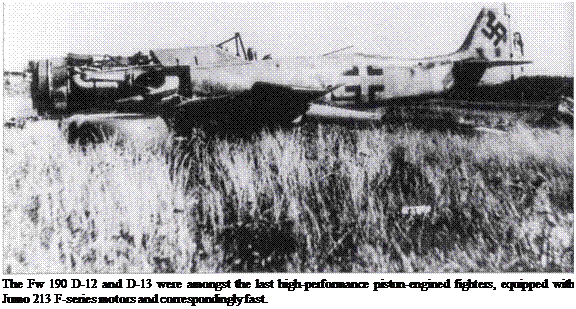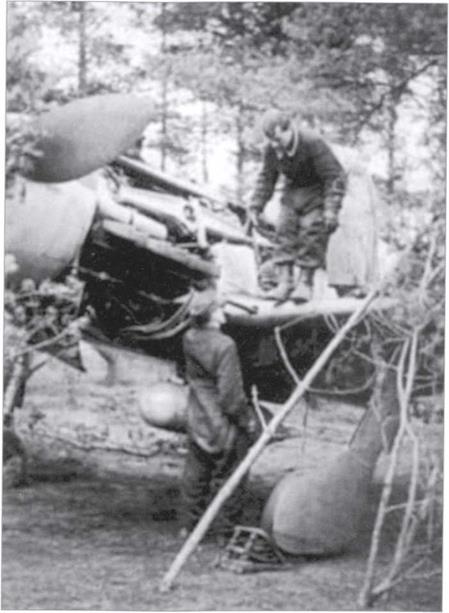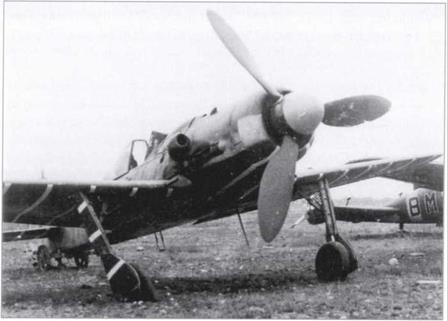From the Fw 190 AS to D-15
Besides the various versions of Bf 109 G-6, G-10, G-14 and K-4, and the late Fw 190 variants A-8 to A-10, the Fw 190 D-9 fighter and Та 152 were seen to be the most significant piston aircraft for Reich defence. After the Fw 190 A-8 run was finally completed in January 1945 at Fieseler Kassel, Ago at Ochsersleben and in the Norddeutsche Werke at Wismar, the A-9, which had been in production since September 1944, grew in importance. By February it had taken over from the A-8 series in the Focke-Wulf works at Cottbus and Aslau and at Dornier Wismar. The better armoured machine had an engine which differed little from its forerunner. Because Fw 190 ‘Dora’ fitted with a Jumo 213 was tactically superior, production of the Fw 190 A-9 with a BMW 801 engine gave way to it in February 1945. All succeeding Fw fighters were to be converted as soon as possible to the more powerful Jumo 213 E-l and F-l.
|
As many of the larger aerodromes were destroyed, operational units resorted to makeshift bases. This photo shows an Fw 190 D-9. |
From mid-1944 the Fw 190 D-9 had been an outstandingly reliable fighter which was now replacing the Fw 190 A-8 and A-9 in the fighter units on a large scale. The planned series production of the A-10 and D-10 was cancelled in favour of improved versions of the D-9.
 |
Fw 190 D-9 to D-13 variants fitted with the Jumo 213 A to F engines were amongst the best German fighter aircraft at the war s end. Shortly beforehand the first D-ll appeared, an outstandingly efficient fighter with Jumo 213 E-l/F-1 engine and turbocharger. The first prototypes were manufactured at the end of September 1944 at Adelheide (Delmenhorst), and by April 1945 20 machines, some fitted with the new EZ 42 gunsight, had been completed.
In the previous October Roluf Lucht had demanded an immediate production run of engines with two-stage chargers for all modern piston-engined fighters. As the first major production run, the Fw 190 D-12 was to be equipped from the outset with the Jumo 213 F-l and MW 50 high pressure installation. This involved a slight modification of the Jumo 213 E-l engine. The aircraft were to have an MK 108 and only two MG 151s in the wing roots. In the spring of 1945 series production of this version fell by the wayside with the preference for the D-13 and the loss of the MK 108 manufacturing plant at Posen to the Soviets.
Five prototypes of the Fw 190 D-13 with Jumo 213 F were built. Series production was scheduled for March 1945 but was abandoned due to the war
 |
This Fw 190 D-12/R5 attached to a training unit for future Staffel-leaders was abandoned near Bad Worishofen.
|
|
These Fw 190 D-9s and D-lls of the‘Parrot Staffer took over the immediate protection of Galland’s Jagdverband 44.
situation. The difference from the D-12 was its MG 151 cannon. A number of D-13 variants had two MK 108s as additional weapons in the wings. In March 1945 three machines were ready for the front and presumably at the beginning of April a few others became available with variations in the fixed weaponry.
Focke-Wulf built probably only two, possibly three Fw 190 D-14 prototypes up to April 1945. The last variant evaluated by the Chief-TLR in January 1945 was the D-15. As with the D-14, this machine would have had a DB 603 E or LA engine instead of the Jumo 213 A, E or F. By the wars end the only captured D-15 prototype (Works Number 500645) was fitted with only a DB 603 G engine but had a larger tailplane as did the Та 152.
Amongst the last operations flown with the Fw 190 D was the protection of the jet units transferring to southern Germany, mainly the remnants of JG 7, KG 51 and KG(J) 54 together with the legendary fighter unit JV 44, which withdrew to Innsbruck via Munich and Salzburg. Some Та 152 pilots landed on airfields in Schleswig-Holstein, where their machines were captured by British forces.












